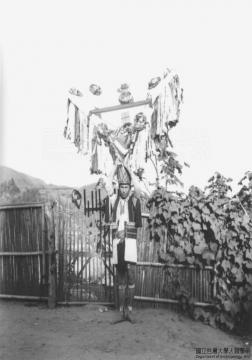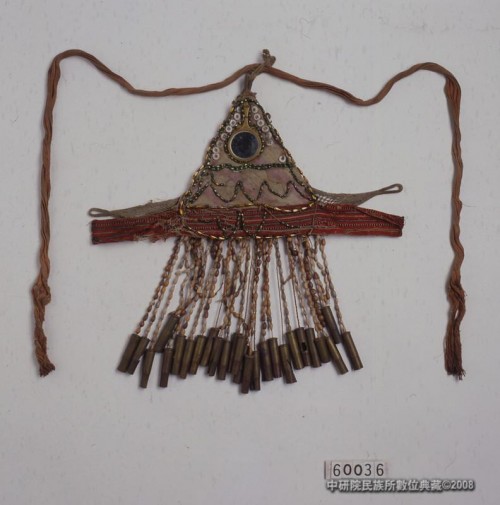TELDAP Collections
| A Past that Has Witnessed Gratitude and Resentment: The Legend of the Pas-ta’ai |
|
About the Saisiyat
The Saisiyat people can be geographically divided into northern and southern branches. The northern Saisiyat are based in Wufong Township in Hsinchu County, while the southern Saisiyat mostly inhabit Nanzhuang Township and Shitan Township in Miaoli County. Compared with the other indigenous peoples in Taiwan, the Saisiyat have a more sparse population. Statistics conducted in late April 2011 by the Department of Household Registration, Ministry of the Interior, show that the fourteen officially recognized indigenous peoples have a population of over 510,000, of which the Saisiyat people account for only around 6,000, thus occupying the tenth place.
The Origin of the Pas-ta’ai
The Pas-ta’ai, also referred to as the Ritual to the Short People or the Ritual to the Spirits of the Pygmies, is a significant traditional ceremony in which all members of the Saisiyat are expected to participate. The Pas-ta’ai is held every two years, and there is also a special decennial ceremony. The story of the Pas-ta’ai varies in detail. According to one version, a long time ago, the short people, who were less than a meter high, lived on peaceful terms with the Saisiyat on the other side of the river and taught them husbandry skills. These pygmies excelled in singing and dancing, and the Saisiyat used to invite their short friends to partake in their annual harvest festivals. The short people, however, were lascivious and often made advances towards the Saisiyat women during these festivals. The Saisiyat resented but endured such outrages, until one day, a youth, enlisting the help of his fellow tribesmen, decided to take revenge upon the short people. There was a sturdy tree on which the short people used to rest on their way home. The Saisiyat cut the tree half way through the trunk and concealed the cut with mud. When the short people, as usual, climbed onto the tree to take their rest, the trunk, not able to bear their weight, eventually broke, and all the pygmies, except for two elders, fell from the cliff and perished. It was from these two surviving elders that the Saisiyat learned the songs and dances of the Pas-ta’ai. As only the Titiyon family completely mastered the ritual, they and their descendants have been in charge of the Pas-ta’ai ever since. The two elders subsequently left for the east. In the wake of the dire revenge, the Saisiyat suffered from a severe famine, and, in order to appease the spirits of the dead pygmies, they began to hold the Pas-ta’ai and beg for forgiveness.
 The second son of the Taai chieftain demonstrates the type of headdress worn by dancers during the Pas-ta’ai, photograph taken in 1936.
(Source: Department of Anthropology, National Taiwan University)
The protagonists of the Pas-ta’ai legend—the short people or black pygmies—are mentioned in the chapter on Saisiyat legends in the Surveys of the Customs of Barbarian Tribes (1915), which was commissioned and subsidized by the Provisional Committee on the Investigation of Taiwan Old Customs (affiliated with the Office of the Governor-General of Taiwan), and completed by the joint efforts of the committee member Yoshimichi Kojima and the employed researcher Shinzo Yasuhara. According to the chapter, the short people had strong arms, saved the Saisiyat people with silvergrass and excelled in wizardry and the magic of invisibility. Did the short people really exist in Taiwan? Despite the fact that tales relating to the short people are a common feature of the Tsou, the Bunun and the Paiwan, among others, anthropological evidence has yet to be produced to prove their existence in Taiwan.
Introduction to the Pas-ta’ai Ceremony
The Pas-ta’ai is traditionally in the charge of the Titiyon family, and the ceremony is held in Shiangtian Lake, Donghe Village, Nanzhuang Township (the southern ceremonial group) and in Taai Village, Wufong Township (the northern ceremonial group). The southern Pas-ta’ai takes place one day earlier than its northern counterpart, and the two differ in detail. One or two months before the Pas-ta’ai, the southern and northern ceremonial groups send their delegates to decide on an appropriate date, which is around the fifteenth of the tenth month in the lunar calendar. Subsequently, preparations are begun and ceremonial songs, forbidden on other occasions, are practiced; meantime, various tribal taboos are to be carefully observed, and the silvergrass, seen everywhere, serves to bring about peace and to ward off evil. The rituals, dances and songs performed in the Pas-ta’ai are exceptionally complex, consisting of the five phases of raraol (welcoming the spirits), kisirinaolan (treating the spirits), kisitomal (entertaining the spirits), papatnawasak (chasing the spirits) and papaosa (sending off the spirits) (Xiuche Lin: 2000). Following the five phases is the “post-ritual ceremony,” which brings the Pas-ta’ai to a close.
 Tied Silvergrass above the entrance to a house in the Taai tribe during the Pas-ta’ai, photograph taken in 1936.
(Source: Department of Anthropology, National Taiwan University)
A sleeveless open-front vest for the Pas-ta’ai.
(Source: Institute of Ethnology, Academia Sinica)
Hip ornaments for the Pas-ta’ai dances.
(Source: Institute of Ethnology, Academia Sinica)
Influences of external forces
The southern and northern Pas-ta’ai ceremonies were officially designated as Taiwan’s Cultural Heritage in 2009 and 2010 respectively, which means that the traditional culture of the Saisiyat people has already been accorded great respect. However, over the years, certain external forces have had negative repercussions on the Pas-ta’ai, including the improper intervention of government administrative sectors, the biased coverage of the media, the clamor and other taboo-breaking behaviors of ignorant tourists, and the proliferation of rubbish and pollution. Since tourism cannot be stemmed, it is important for everyone to respect and cultivate a deeper understanding of Saisiyat culture.
References:
Department of Household Registration, Ministry of the Interior.
Xiuche Lin (2000). History of Taiwan’s Aborigines: The Saisiyat. Nantou City: Historical Records Committee of Taiwan Province.
Yuan-Yi Huang (2008). When “Ta’ay” is Confronted with “Journalists”: A Study of tourism and news coverage of the Pas-ta’ai. Master’s Thesis, Graduate Institute of Journalism, National Taiwan University.
Provisional Committee on the Investigation of Taiwan Old Customs, Office of the Governor-General of Taiwan. Translated by the Institute of Ethnology, Academia Sinica (1998). Surveys of the Customs of Barbarian Tribes, Third Volume, The Saisiyat. Taipei: Institute of Ethnology, Academia Sinica.
Bin-Xiong Liu and Tai-Li Hu (1987). A Study of the Traditional Ceremonies, Songs and Dances of Taiwan’s Aborigines. Nantou County: Department of Household Registration, Government of Taiwan Province.
|













